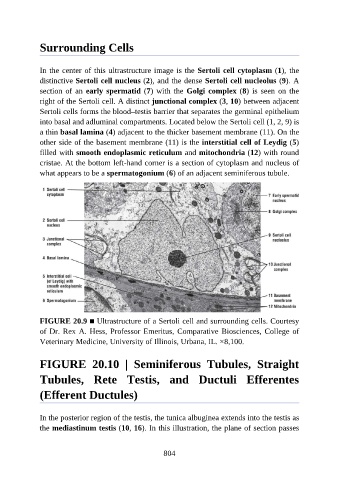Page 805 - Atlas of Histology with Functional Correlations
P. 805
Surrounding Cells
In the center of this ultrastructure image is the Sertoli cell cytoplasm (1), the
distinctive Sertoli cell nucleus (2), and the dense Sertoli cell nucleolus (9). A
section of an early spermatid (7) with the Golgi complex (8) is seen on the
right of the Sertoli cell. A distinct junctional complex (3, 10) between adjacent
Sertoli cells forms the blood–testis barrier that separates the germinal epithelium
into basal and adluminal compartments. Located below the Sertoli cell (1, 2, 9) is
a thin basal lamina (4) adjacent to the thicker basement membrane (11). On the
other side of the basement membrane (11) is the interstitial cell of Leydig (5)
filled with smooth endoplasmic reticulum and mitochondria (12) with round
cristae. At the bottom left-hand corner is a section of cytoplasm and nucleus of
what appears to be a spermatogonium (6) of an adjacent seminiferous tubule.
FIGURE 20.9 ■ Ultrastructure of a Sertoli cell and surrounding cells. Courtesy
of Dr. Rex A. Hess, Professor Emeritus, Comparative Biosciences, College of
Veterinary Medicine, University of Illinois, Urbana, IL. ×8,100.
FIGURE 20.10 | Seminiferous Tubules, Straight
Tubules, Rete Testis, and Ductuli Efferentes
(Efferent Ductules)
In the posterior region of the testis, the tunica albuginea extends into the testis as
the mediastinum testis (10, 16). In this illustration, the plane of section passes
804

